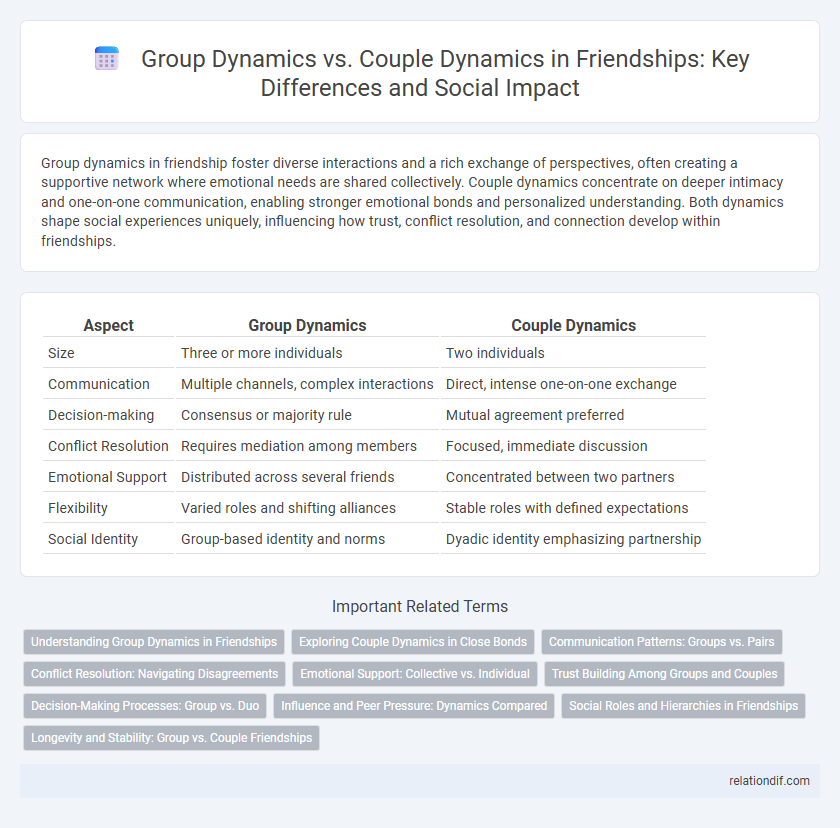Group dynamics in friendship foster diverse interactions and a rich exchange of perspectives, often creating a supportive network where emotional needs are shared collectively. Couple dynamics concentrate on deeper intimacy and one-on-one communication, enabling stronger emotional bonds and personalized understanding. Both dynamics shape social experiences uniquely, influencing how trust, conflict resolution, and connection develop within friendships.
Table of Comparison
| Aspect | Group Dynamics | Couple Dynamics |
|---|---|---|
| Size | Three or more individuals | Two individuals |
| Communication | Multiple channels, complex interactions | Direct, intense one-on-one exchange |
| Decision-making | Consensus or majority rule | Mutual agreement preferred |
| Conflict Resolution | Requires mediation among members | Focused, immediate discussion |
| Emotional Support | Distributed across several friends | Concentrated between two partners |
| Flexibility | Varied roles and shifting alliances | Stable roles with defined expectations |
| Social Identity | Group-based identity and norms | Dyadic identity emphasizing partnership |
Understanding Group Dynamics in Friendships
Understanding group dynamics in friendships reveals complex interactions that differ significantly from couple dynamics, where intimacy centers on one-to-one connections. Group friendships involve navigating diverse personalities, shared goals, and collective decision-making, which can enhance social support but also introduce challenges like conflict resolution and role negotiation. Recognizing these patterns fosters stronger bonds, improves communication, and enhances emotional resilience within social groups.
Exploring Couple Dynamics in Close Bonds
Couple dynamics in close bonds often involve deep emotional intimacy, mutual reliance, and continuous negotiation of roles, which differ significantly from group dynamics where interactions are more complex and less intimate. Within couples, communication tends to be more direct and personalized, fostering trust and vulnerability that strengthen the relationship. Understanding these unique elements of couple dynamics is essential for promoting emotional well-being and long-term relational satisfaction.
Communication Patterns: Groups vs. Pairs
Communication patterns in group dynamics often involve multiple simultaneous interactions, requiring active listening and turn-taking to ensure all voices are heard. Conversely, couple dynamics tend to feature more intimate, direct exchanges with deeper emotional disclosure and immediate feedback. Effective communication in groups relies on managing diverse perspectives, while couples focus on mutual understanding and emotional synchronization.
Conflict Resolution: Navigating Disagreements
Group dynamics in friendship often involve navigating multiple perspectives, requiring collaborative communication and compromise to resolve conflicts effectively. Couple dynamics tend to focus on addressing disagreements through direct, intimate dialogue, prioritizing emotional understanding and mutual support. Successful conflict resolution in both contexts depends on active listening and empathy, tailored to the relational structure.
Emotional Support: Collective vs. Individual
Group dynamics provide a broad emotional support network where members share diverse perspectives, fostering resilience through collective empathy and shared experiences. In couple dynamics, emotional support tends to be more personalized and intense, centered on deep, individual connection and mutual understanding between partners. Both forms of support offer unique benefits, with groups enhancing social belonging and couples strengthening intimate emotional bonds.
Trust Building Among Groups and Couples
Trust building in group dynamics relies heavily on consistent communication, shared experiences, and collective problem-solving that strengthens interpersonal bonds among multiple members. In contrast, couple dynamics focus more intensively on emotional intimacy, vulnerability, and one-on-one commitment, fostering a deeper personalized trust. Both contexts demand reliability and honesty, but group trust emphasizes transparency across interactions while couples prioritize emotional attunement and mutual support.
Decision-Making Processes: Group vs. Duo
Group decision-making typically involves diverse perspectives, leading to more comprehensive solutions but often requiring longer deliberation and consensus-building. In contrast, couples tend to navigate decisions more quickly due to fewer participants and stronger emotional bonds, which streamline communication and compromise. Understanding these dynamics helps in tailoring conflict resolution and collaboration strategies to fit either group or duo relationships effectively.
Influence and Peer Pressure: Dynamics Compared
Group dynamics in friendships often involve complex layers of influence and peer pressure, where individuals navigate multiple relationships simultaneously, balancing conformity with personal identity. In couple dynamics, influence tends to be more intimate and direct, with partners exerting emotional and behavioral impact within a dyadic framework. Peer pressure in groups can encourage collective behavior shifts, while in couples it usually manifests through mutual support or subtle persuasion, affecting decision-making and emotional well-being.
Social Roles and Hierarchies in Friendships
In group dynamics, social roles and hierarchies often emerge organically, with individuals adopting roles such as leader, mediator, or influencer to maintain group cohesion. Couple dynamics, however, typically feature more fluid and egalitarian role distribution, emphasizing mutual support and intimate understanding. Understanding these distinctions in social roles helps clarify how group influence and dyadic intimacy function differently within friendships.
Longevity and Stability: Group vs. Couple Friendships
Group friendships often demonstrate greater longevity and stability due to diverse social support networks and shared activities that reinforce bonds over time. Couple friendships can be more vulnerable to fluctuations since dynamics depend heavily on dyadic compatibility and individual life changes. Research shows that while couple friendships offer intense emotional connection, group friendships typically provide broader resilience against social stressors.
group dynamics vs couple dynamics Infographic

 relationdif.com
relationdif.com